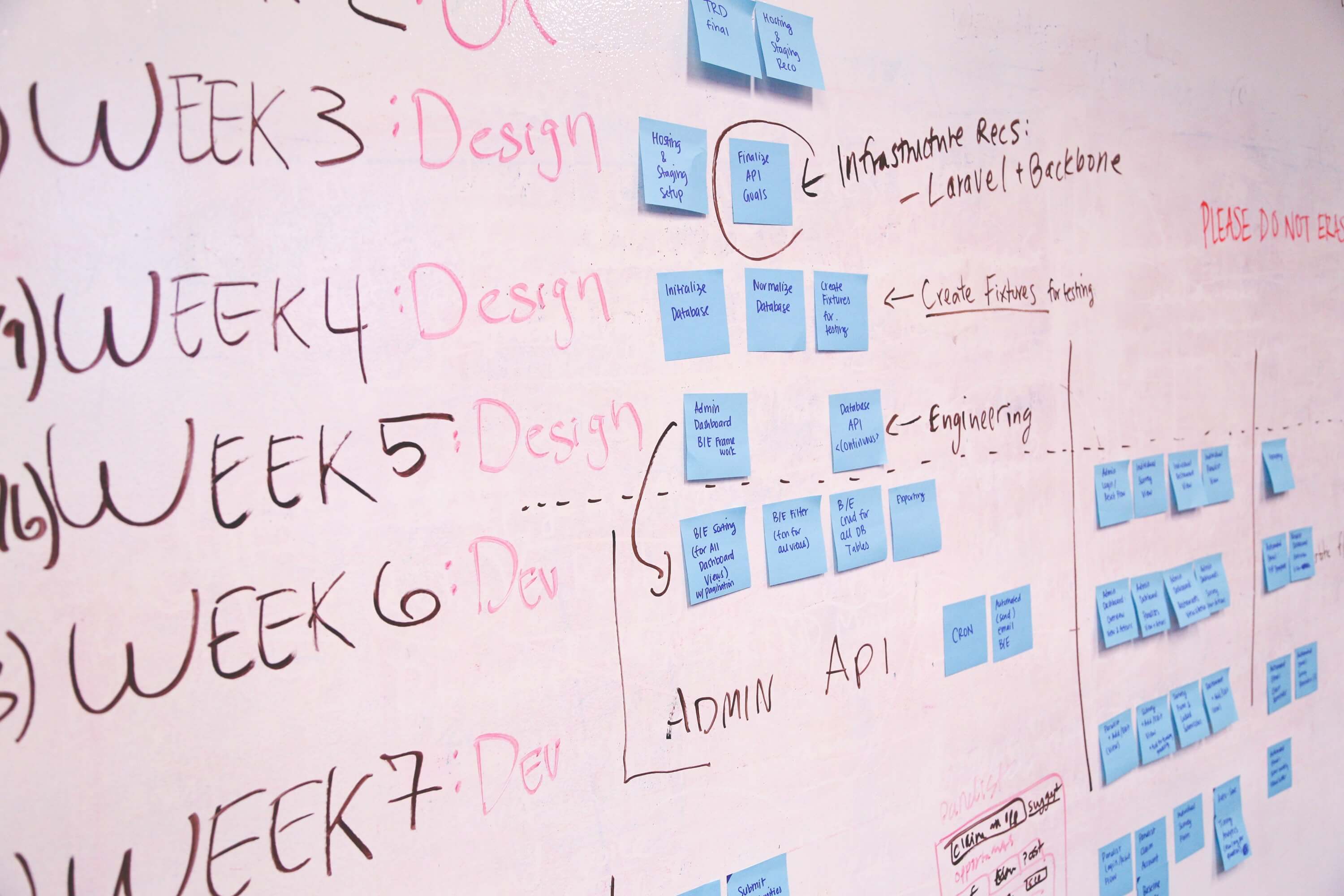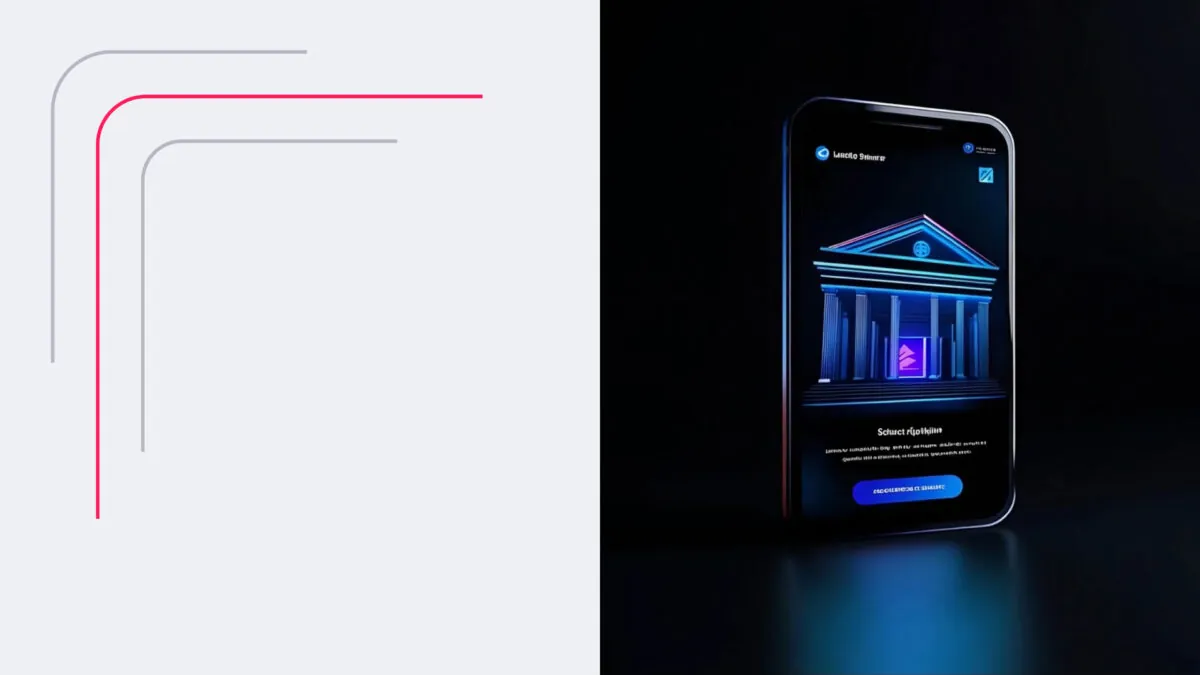MVPs are a fast way for you to get into a market while enhancing your customers’ experience. Creating a product and shipping it out the door before your competitor is the cornerstone of competitive business, and the banking sector is no different.
We want to explore the concept of developing an MVP in banking and how the process can help your company get new and exciting products into the hands of your customers while improving their banking MVP experience.
What is the purpose of MVP in banking?
An MVP, or Minimum Viable Product, is simply a good product idea that is released as quickly as possible while maintaining a high standard of quality, functionality and usefulness.
It can be thought of as a rapid prototyping and deployment development style that is usually a collaboration between partners and technologies with a solid idea or proof of concept.
It encourages a mindset that accepts failure and demands innovation. It is a Lean framework that favors simplicity over-complicated products and development.
In the banking and Fintech sector, this is quite difficult to do because when it comes to finances there can be no errors. Imagine logging into your banking app only to find that your balance is not correct. You would not want to do business with a bank that couldn't guarantee your funds. For this reason, a lot of a product development team's time will be spent on identifying problems and edge cases that could cause major issues further down the road.
Banking is also a highly regulated market: if you do not comply with the set standards of the regulatory body in your country or region then you risk not being allowed to compete in the market.
This can be as a result of a fine, license revocation, or any other serious punitive measure that a regulatory authority might issue to your company. With these 2 examples in mind, you need to think about the exposure to risk that you are opening yourself up to by rushing to the market first with a brilliant idea.
Download our free whitepaper FinTech Security and Regulatory Compliance. Best practices and checklists.

How to prioritize and decide on an initial (and relevant) feature set for MVP
Having a great idea is the easy part of app development. However, deciding what actually ships with a product is quite another matter.
The timeline of many of the development cycle steps is drastically decreased in order to meet the strict deadlines that are set out by the project’s release dates. The key to successfully launching your banking MVP is prioritizing features and functionality with each release.
It is important to remember that this is a Minimum Viable Product, so what stays and what goes in the initial release I paramount to successfully launching the MVP in Banking.
If you get into the market and start attracting customers with a defective product or service, then you encounter two immediate issues: customer dissatisfaction and regulatory scrutiny.
Both of these issues will affect your product and company going forward. You will also lose the momentum that your product launch gained in the first place, giving your competitors the edge and an advantage over you.
Research and investigating your idea is paramount if you are going to successfully launch anything in the banking sector.
The competition is intense and the margins between competitors are very low. This means that the impact that a single functioning product has on the market is massive. Getting an MVP out of the gates first is crucial in the competitive world of finance and banking.
The advantages of releasing an MVP is that there is room for further growth and enhancements.
You can start to experiment with new features as the product scales. New features and enhanced services that are tested and released can be packaged as part of a pricing hierarchy, giving your customers the choice of spending more money to access additional functionality.
As your product matures, you can then start to build upon the tried and tested features of the MVP and sculpt it into an industry-leading example of how a product should be.
You, therefore, need to prioritize your banking MVP features according to your market research. What are the most sought after features in your app? What are the most beneficial parts of the product to your customers? Which are the easiest to implement? Which features add the most value to your product stack and encourage user interaction? All of these key features must be weighed and prioritized when you release your product into the market.
Because of the outlined pressure and competition in this market, it is absolutely necessary for banking institutions to explore new products and iterate them rapidly if they are to differentiate themselves from the competition. We, therefore, need to think about an MVP not as the solution to a marketing problem, but rather as the starting point of exciting innovation and invention in an already crowded market.
Finding the Right Banking MVP Partner
The process of MVP development is an iterative one, which means that what you release today will soon be updated and built upon based on the customer and market feedback.
You can think of an MVP as a work in progress that needs to fulfil specific needs from the first day of its deployment. This is where prioritization comes into play.
In order to successfully do this in the planning stages of your app, you need a highly-skilled partner that understands how critical this is to the overall success of your product.
S-PRO is able to fill the role of a technical and advisory partner that has access to the most critical tools in app development and analysis.
S-PRO can conduct market analysis, competitor analysis, SWOT analysis, and a complete and detailed project analysis during the finalization and approval stages of your MVP’s development life cycle.
S-PRO understands Fintech and Open Banking requirements and can help you with your next project.
Choosing Between Custom Development and White-Label Banking Solutions
First off, let’s clarify what a white label product is - a piece of software that’s already fully functional and operated by some company. It is then stripped of any branding and logos, while still retaining the underlying MVP architecture. That way, a single company can sell its solution over and over again, catering to the entire fintech sector.
Now, it’s clear what the developer gets, as they make just one product that then brings revenue over and over. But what’s the advantage of buying a white-label solution for the finance company? Well, a white-label minimum viable product will be cheaper than building your own software from the ground up, which is already a huge pro.
Buying an actively used product means you will know exactly how it works, where it may be lacking, and how well it performs in the actual banking industry. Eliminating that uncertainty is certainly a plus, especially in a sector as delicate as finance, where faulty software could irreparably damage a company’s reputation.
That isn’t to say a white-label product is better than a custom MVP. For example, building your own solution means you can handpick features. You can focus your services to set your product and company apart from others. Moreover, you’ll be in charge of the architecture, determining your own priorities and basing the resulting solution on that.
Should you want to make a sprawling digital banking platform, using AI for automation and analytics, it will be easier to stay compliant by training your own models and securing them. Relying entirely on third-party work for solutions that process sensitive data is a gamble in and of itself, even if many others may be doing it. After all, cases like the Cloudflare outages show that even reliable tools may let us down eventually.
In the end, it’s important to remember that custom fintech MVP development isn’t just about prestige. It’s a guarantee of quality, security, and functionality that outpaces competitors.
MVP for Banking Services: A Step-by-Step Development Guide
A minimum viable product is a common concept in software development. In the finance industry, it allows the bank or service provider to enter the market as soon as possible while keeping the initial expenses low. Once the product reaches customers, developers can collect feedback and improve the product to meet and exceed user expectations.
Building an MVP full form comes with some challenges. Here’s what the process looks like in the finance industry.
1. Analyze the Market
Your first task is to ensure that customers need your product. Start by analyzing their specific pain points and requirements, along with the solutions already available.
The next step is to identify potential users and ask them for feedback. You can conduct interviews to receive opinions regarding the product. You probably have some assumptions on what the product should resolve. The goal of market research is to confirm that it aligns with their expectations. You might even make some adjustments in the process, to end up creating a better product in the MVP full-form phase.
2. Define Your Objectives and Goals
The actual goals and expectations you have from the product can vary. Banks might want an all-around customer app, and lending platforms will be focusing on that service and challenges specific to that area.
While defining the goals of your MVP in banking, analyze the unique value of your product. If you are a lending platform, do you offer better rates compared to rivals? And if you offer a payment solution, is your goal to deliver faster or more affordable payments for consumers? Answering these questions can assist in determining the direction in which you’ll take your fintech product.
3. Identify User Flows
A user flow is the entire trip that the consumer takes from the moment they start using your product to finishing the desired task. While creating an MVP in finance, step into your user’s shoes. The process will likely begin by registering an account and going through the KYC process.
After verifying their credentials, users will likely enter the home screen. From here, opening the desired service should be easy. Whether they want to check transaction history or current loan summary, the task should be completed in as few clicks as possible. Once you identify user flow, it will be easier to create an attractive design and a user-friendly interface.
4. The Key Features to Include
The next step is to decide which features to add to your MVP. The finance industry comes with stiff competition. Your minimum viable product should have core functionality, so prioritize features and choose the most important ones for customers to benefit from the service you provide and for you to enter the market quickly.
At this point, your market research helped you figure out user expectations and the product value you can offer them. Now, browse through your competitors. Is there something to offer that can make you stand out from the crowd?
Don’t forget to consider which features are mandatory for a user. For example, a personal finance app should have at least some expense-tracking tools, while advanced financial insights could come later.
5. Consider the Technical Issues
Before starting the development, consider the technical requirements, with the tech stack being the initial concern. Pick programming languages, tools, libraries, and frameworks that align with your product requirements, even beyond the MVP phase.
Design principles and architecture patterns should consider flexibility and scalability. Mechanisms applied are to be focused on optimal data management and smooth integrations with third-party software. Once all details are settled, you can be sure that your final product will be reliable, scalable, and ready to face the challenges that the banking sector presents.
6. Test and Release the MVP
You should avoid releasing an MVP full form before thoroughly testing it. No matter how close the deadline is – disappointing the customers with a slimmed-down product version is hard to fix later.
Once you get the product ready, test its functionality and performance. It’s not only about ensuring all features work properly but also confirming that the system can handle different user loads. Another major consideration is taking care of potential vulnerabilities since security is a top priority.

Real-World Examples of Successful Banking MVPs
Perhaps one of the most sprawling examples of MVP in the financial industry would be Project mBridge. This collaborative project brought together central banks and monetary authorities from several countries, including Indonesia, France, and the New York Innovation Centre of the Federal Reserve Bank of New York.
Using distributed ledger technology, the platform created a space that simplified cross-border payments and enabled real‑value CBDC and foreign exchange transactions. Founding central banks deployed their own validating nodes to build trust and ensure resilience, setting the stage for broader collaboration. As a result, this minimum viable product isn’t just an interesting experiment but a practical tool for international cooperation.
Another example of great minimum viable bank software is Treezor’s mobile banking constructor. This ambitious product was designed as a banking app for the BaaS business, matching its branding and fully complying with regulations like PSD2 and GDPR. However, beyond simply delivering a sleek, modern digital banking solution, the app grew into something more.
Thanks to how flexible the overall architecture of this solution is, Treezor’s app can itself serve as an MVP for other finance institutions to grow and expand on. Thanks to that, more banks can embrace the digital space using S-PRO’s quality work as a jumpstart for their online presence. Thanks to the MVP being designed for a respected European finance company, it adheres to all relevant regulations and quality standards that a bank could look for.
Components of an Effective MVP in Banking
We are now better familiar with the process, so let’s discuss the crucial components to include in an MVP in banking. The usual approach includes the following:
- Registration process and KYC
- Multi-factor authentication
- Managing accounts and cards
- Checking transaction history
In the back office, managing customers, accounts, KYC, fees, and exchange rates are some of the basic features, along with a customer support system. Here are the elements that developers should consider when developing a minimum viable bank application!
User Experience
The general rule is simple – create a user-friendly interface. Most developers go with the minimalist design trend that makes the entire navigation system easy. In banking, user goals include transferring funds to someone, checking their account details, or locating an ATM. Whatever the goal is, a user should achieve it effortlessly when using the app or website.
While developing an MVP in finance, consider who your users are. Is the solution primarily designed for business or individual customers? What finance-related services would the company like to offer them? Is the idea to create a mobile app, or there’ll be a website version, too?
Understanding your target audience can be a crucial part of optimal user experience. That’s why creating an accurate user persona is recommended. Frequent interface testing is another way to confirm the viability of your design.
Maximum Possible Functionality
A minimum viable bank product only offers limited functions. That makes it imperative to perfect those functions and ensure everything works to the smallest details. That brings us back to testing. You can use A/B testing and other methods while in the MVP phase. But even before you enter it, make sure that there are no major glitches that would compromise using the existing software features.
The Question of Scalability
From the perspective of developers and companies offering financial services, scalability is a major consideration. The market is constantly evolving, so keeping up with the trends is vital. That’s why the concept of SaaS or Software-as-a-Service products based on a cloud is commonly used these days. A cloud solution ensures you can scale down or up depending on your requirements.
Developers should have scalability in mind during the process. There’s no point in creating a solution that you can’t scale. It’s important to work with developers who use recent technologies and approaches that can deal with large data storage and traffic.
UX/UI Principles for Banking MVPs
An MVP may not 100% reflect what the final version of the product will look like. Yet, it must still provide a high level of quality and demonstrate the product's full potential. That desire to deliver polished, user-centric design is a natural ambition of any company, but that quality takes time. Meanwhile, the philosophy of fintech MVP development is all about delivering a product as fast as possible whilst still balancing speed with results.
Your core principle for UI/UX design should be this: use your time wisely and put in the effort on every single element. This may seem like an obvious conclusion, especially in the competitive fintech market, but far too many businesses put design last. We can understand that perspective, as security, compliance, and speed are extra valuable in this industry.
However, simple UI/UX is no less vital, as it helps onboard new clients and get them comfortable with your product. Research shows that users are more engaged and more favorable toward the product when usability is high. The world of finance software is no exception, as branding and simplicity are key in retaining users.
Regardless of how complex your MVP architecture may be behind the scenes, app design has to make a good first impression and funnel users toward entrusting you with their finances. This means crafting a simple registration process, personalizing from the first steps, and outlining your software’s pros.
Making a digital banking platform with good design also involves practices aimed explicitly at retention, such as:
- Loyalty rewards;
- Bonus programs;
- Personalized offers;
- Accessibility and inclusivity features.
The latter is particularly important for the actual UI/UX development, as your minimum viable product should be usable by anyone. Users who are vision-impaired, dyslexic, lacking technical knowledge, and reluctant to digitize banking completely shouldn’t be left behind. Ensure that your design includes guiding elements for them, providing an easy on-ramp for users.
Regulatory and Compliance Considerations for Banking MVPs
As with any banking product, minimum viable bank software must obey the numerous legal limitations set for the financial industry. That means your team should familiarize itself with the up-to-date regulations and consider how they impact the product and its functionality.
On the one hand, making a minimum viable product could be easier for those concerned about regulations. It will have fewer extra functions and complicated parts of its architecture. Therefore, it became easier to tailor to legal regulations. However, an MVP is built to grow and you will inevitably face new compliance challenges later.
The rule of thumb here is to prioritize security and privacy for any financial data your app will handle. Customers should be able to see their own information and control it, such as being able to remove it to request a full copy. On the business side, that data should be stored with reliable encryption, and the same standards apply to any data transit that occurs.
Your finance app should also come with a user agreement that’s as thorough as the contract a customer would sign when joining the bank. After all, you will be providing many of the same services digitally and working with the same data. There’s also the fact that the digital space comes with some unique regulations, like the upcoming FDIC signage rule enforcement.
Similarly, any use of automated and AI-powered valuation and estimation models will also be subject to scrutiny and regulation. Therefore, if you want to include such features in your MVP, your team will need to keep an eye on how the legal framework around this issue develops.
How AI and ML Technologies Enhance MVP Implementations in the Banking Industry
A minimum viable bank product relies on user feedback to improve. Launching an MVP in banking is only the beginning. You then start to gather user opinions, better understand consumer requirements, and design strategies to improve the product while keeping the investment minimal.
Artificial intelligence and machine learning technologies can completely revolutionize the development approach to the MVP creation. Computers can collect large amounts of data provided by customers at a faster rate than humans and they don’t make mistakes thanks to programmability. Meanwhile, people can focus on other tasks that require manual work or human interaction.
Using AI and ML to understand customer needs better can help even after you develop the MVP full form. A machine learning algorithm can analyze user behavior and create personalized recommendations for certain banking services. It’s similar to how Netflix makes recommendations based on the shows you previously watched.
AI and ML tools can also help organize customer data via different channels. They can integrated data from the app and the website, automate cleaning from duplicates, segment your clients based on certain criteria, etc. They are invaluable to businesses and developers, providing insights into user behavior and optimizing the working process. Your MVP in finance will significantly benefit from integrating these technologies into the development process.
Cost Estimation: How Much Does It Take to Build a Banking MVP?
The cost of making a minimum viable bank solution will vary broadly depending on the typical factors that usually influence software development. Things like your team’s region of residence, experience, and make-up will all be major factors. Similarly, the complexity of your MVP and how much work will be put into its release also determine the final cost.
Let’s say you want to build an MVP that serves as an online branch of your bank from scratch. If you hire a development company from North America, you’re likely to be paying extra compared to a vendor from Eastern Europe or Southeast Asia. However, you’d also be working with experienced professionals with a proven track record. The trick here is finding the right balance.
Most experts would likely recommend recruiting a team from one of the more affordable regions that still has verified successful projects under their belt. That way, you can be sure they will deliver a high-quality minimum viable product without costing you too much.
Since minimum viable banking software will be quite straightforward without any “bells and whistles”, you can keep the expenses manageable by planning ahead. The app’s design should reflect your own branding and offer a straightforward way to navigate the online bank. Its features should also have a high cost-to-value ratio, as you’re trying to get big returns out of minimal input.
In the end, the price tag of your finance MVP could range between $50,000 and $95,000, for example. What matters is whether that cost is reflected in the product's final quality, with the app serving as a worthy extension of your company.
Conclusion
Most great ideas start out as a long list of fantastic features that would be great to release all at once.
The truth of the matter in banking software development is that for each new and innovative product feature that is released, there are many processes in the background that need to be developed (both software and procedural) in order to make them a reality. The more features that are added to the initial release of the product slows down the progress towards releasing the product.
The most important aspect of this process is to feature prioritization before the application development work is undertaken. Valuable resources need to be freed up during development if you are going to get your banking MVP to market first.
Once you have gauged the value and interest of your product then you can start to decide on the next steps. This is where partnering with a company like S-PRO can really save you time and money during the arduous process of banking software development.
A banking MVP can cost as much as $95,000, however, everything is determined by the complexity of the project. Contact S-PRO for an approximate estimate for your project today.






